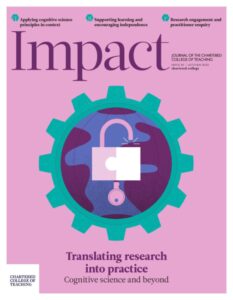Exercise and executive function in the curriculum: What does current research indicate on potential gains in enhancing cognitive development?
Written by: Clare Owen

7 min read
Clare Owen, Hollyfield School, UK
We often view curriculum as the beating heart of a school’s contribution to its community. While finding a definition that suits everyone is near impossible, in whatever form we conceptualise it, it is the engine room of education, the driver of our intent. For that driving force to be as effective as it might be, we must pay attention to the needs of students within and beyond the classroom so that they might best benefit from it. The difficulty with influencing factors beyond pedagogy, such as sleep, nutrition, emotion and exercise, is that while colleagues recognise their importance and the devastating effects that, if served poorly, they can have, they are so idiosyncratic to each child, so nebulous in their own form, that providing for them is complex. Physical activity (PA), given that its importance is already established, may seem the area with the greatest potential for straightforward gains, but could its effects be yet more beneficial to
Join us or sign in now to view the rest of this page
You're viewing this site as a guest, which only allows you to view a limited amount of content.
To view this page and get access to all our resources, join the Chartered College of Teaching (it's free for trainee teachers and half price for ECTs) or log in if you're already a member.
- Coe DP, Pivarnik JM, Womack CJ et al. (2006) Effect of physical education and activity levels on academic achievement in children. Medicine and Science in Sports and Exercise 38: 1515–1519.
- Egger F, Benzing V, Conzelmann A et al. (2019) Boost your brain, while having a break! The effects of long-term cognitively engaging physical activity breaks on children’s executive functions and academic achievement. PLOS ONE 14(3): e0212482.
- Fedewa A and Ahn S (2011) The effects of physical activity and physical fitness on children’s achievement and cognitive outcomes: A meta-analysis. Research Quarterly for Exercise and Sport 82(3): 521–535.
- Hatch L, Dring KJ, Williams RA et al. (2021) Effect of differing durations of high-intensity intermittent activity on cognitive function in adolescents. International Journal of Environmental Research and Public Health 18(21): 11594.
- Hillman C, Castelli D and Buck S (2005) Aerobic fitness and neurocognitive function in healthy preadolescent children. Medicine and Science in Sports and Exercise 37(11): 1967– 1974.
- Lees C and Hopkins J (2013) Effect of aerobic exercise on cognition, academic achievement, and psychosocial function in children: A systematic review of randomized control trials. Preventing Chronic Disease 10(130010): 111–131.
- Public Health England (2021) Physical activity data tool: Statistical commentary, March 2021. Available at: www.gov.uk/government/statistics/physical-activity-data-tool-march-2021-update/physical-activity-data-tool-statistical-commentary-march-2021 (accessed 15 July 2022).
- Takehara K, Togoobaatar G, Kikuchi A et al. (2021) Exercise intervention for academic achievement among children: A randomized controlled trial. Pediatrics 148(5): e2021052808.
- Tomporowski PD, Davis CL, Miller PH et al. (2008) Exercise and children’s intelligence, cognition, and academic achievement. Educational Psychology Review 20(2): 111–131.
- Tomporowski PD, McCullick B, Pendleton DM et al. (2015) Exercise and children’s cognition: The role of exercise characteristics and a place for metacognition. Journal of Sport and Health Science 4(1): 47–55.
- Zhu H, Chen A, Guo W et al. (2020) Which type of exercise is more beneficial for cognitive function? A meta-analysis of the effects of open-skill exercise versus closed-skill exercise among children, adults, and elderly populations. Applied Sciences 10(8): 2737.
- Zurc J and Planinšec J (2022) Associations between physical activity and academic competence: A cross-sectional study among Slovenian primary school students. International Journal of Environmental Research and Public Health 19(2): 623.
0
0
votes
Please Rate this content
Please login to comment
0 Comments
Oldest
Newest
Most Voted
Inline Feedbacks
View all comments










